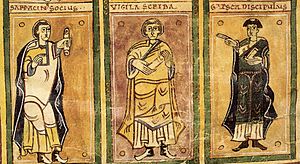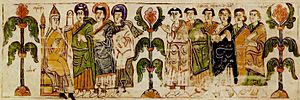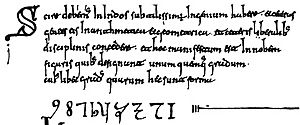Codex Vigilanus facts for kids
The Codex Vigilanus is a very old and special book. It's also called the Codex Albeldensis. This book is an illuminated manuscript, which means it has beautiful pictures and designs. It brings together many important historical papers from ancient times up to the 900s in Hispania (which is now Spain and Portugal).
Inside the Codex, you can find different types of writings. These include old laws from the Visigoths, rules from early popes, and stories about history. One famous story is the Crónica Albeldense. The book also contains different kinds of laws and a calendar. Today, the Codex Vigilanus is kept safe in the library of El Escorial monastery in Spain.
Contents
Who Made the Codex Vigilanus?
Three monks from the Riojan monastery of San Martín de Albelda created this amazing book. Their names were Vigila, Serracino, and García. Vigila was the main artist who drew the pictures. Serracino was his friend, and García was his student.
The monks finished the first version of the book in the year 881. But they kept adding new information until the year 976. The original book is still preserved at El Escorial monastery.
A Center of Learning
When the Codex Vigilanus was being made, the monastery of Albelda was a very important place. It was a center for culture and learning in the Kingdom of Pamplona. The book celebrates not only old kings but also the rulers of Navarre at that time. These included Sancho II of Pamplona and his queen, Urraca. It also honored Sancho's brother, Ramiro Garcés, who was the King of Viguera.
First Arabic Numerals in the West
One of the most interesting things about the Codex Vigilanus is its numbers. It contains some of the very first mentions and drawings of Arabic numerals in Western Europe. These are the numbers we use every day (0, 1, 2, 3, etc.). The Arabs brought these numbers to Spain around the early 900s.
Unique Art Style
The pictures and designs in the Codex Vigilanus are very special. They combine different art styles from that time. You can see influences from Visigothic, Mozarabic, and Carolingian art.
For example, the patterns that look like woven ribbons show Carolingian influence. You can also see some Italo-Byzantine art styles. The way animals are used as decoration is similar to art from the Frankish kingdom. Another book, the Codex Aemilianensis, was copied from the Vigilanus in 992. It shows even more Carolingian influence.
See also
 In Spanish: Crónica albeldense para niños
In Spanish: Crónica albeldense para niños




